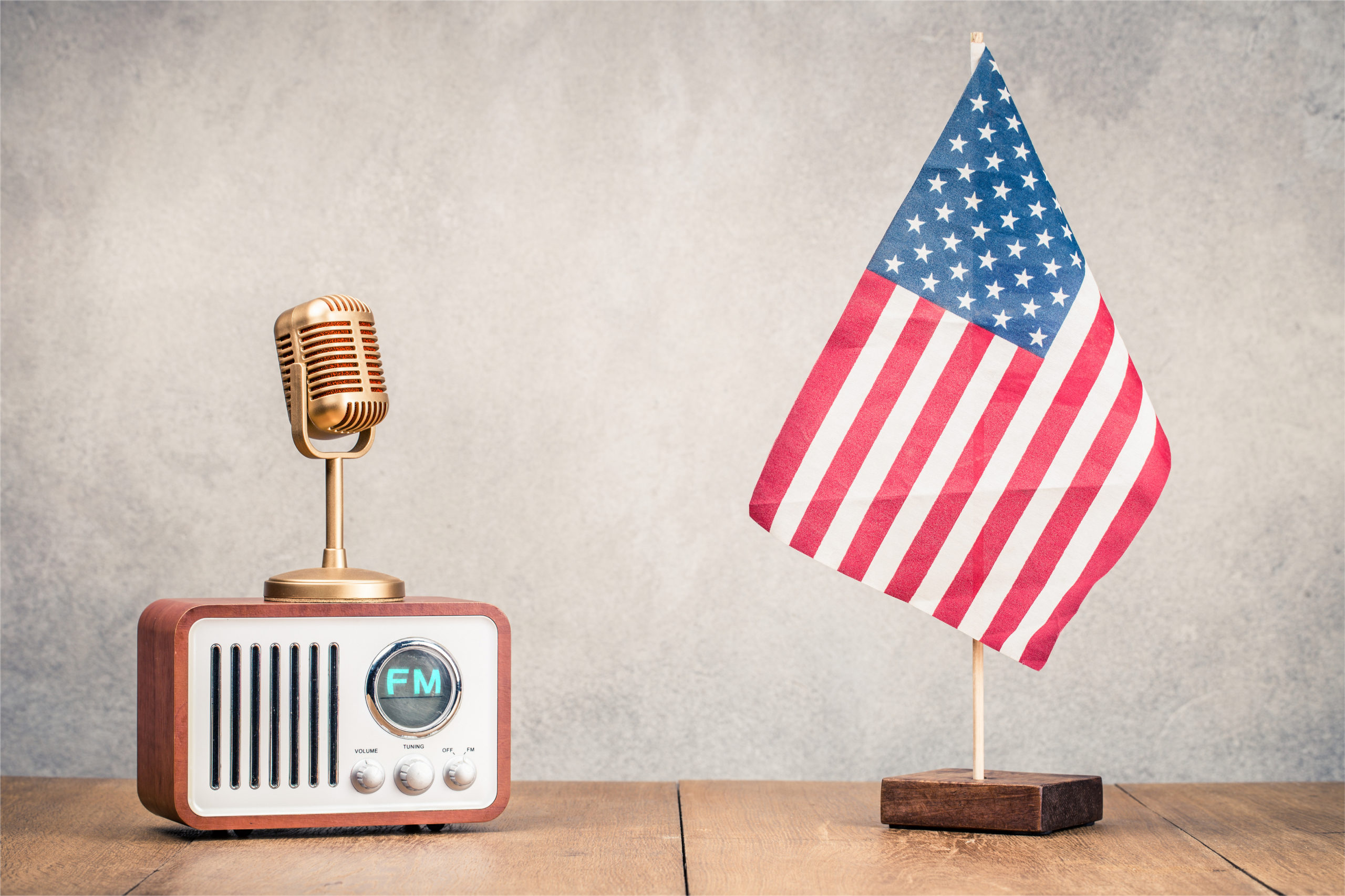
Three weeks from today, the election mercifully will be over (OK, at least the voting part). For broadcast radio, the only sad part of this story is the torrent of political advertising will have likely come to an end.
Yesterday’s post talked about new research that shows the efficacy of radio attribution – a collaboration between General Motors and Taco Bell that shows how radio truly fast food visits.
Chances are in just a few weeks, we may learn how radio drives the vote, especially in those all-important “battleground states.” Depending on the outcome (and how it’s spun), radio just might get a lot of credit for the results – a reversal of fortunes from past years.
Let me take you back nearly seven years to the first (and apparently last) Nielsen Client Conference/Jacobs Media Summit. Arbitron had just sold its assets to Nielsen, and the latter felt obligated to go ahead with an already-planned conference at their Columbia headquarters.
It was a productive day. We presented our Jacobs Summit sessions in the morning, followed by the Nielsen (OK, Arbitron) panels and keynotes in the afternoon. The one that got my attention was uniquely political. Larry Rosin and Joe Lenski from Edison Research, the company that still handles exit polling for the major networks and news organizations, moderated a panel of political consultants. OK, “spin doctors.”
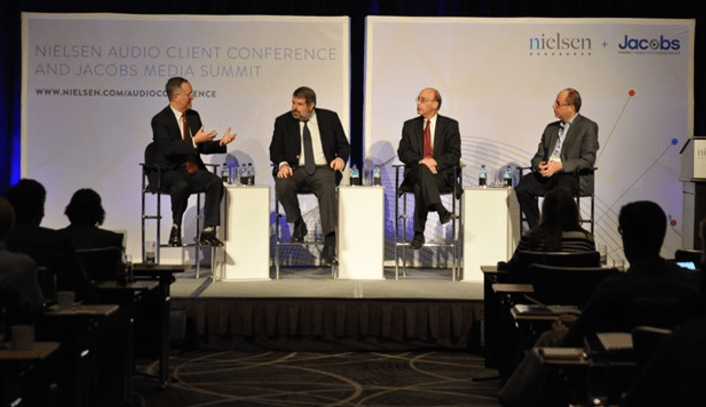
Both political parties were represented – Mark Mellman on the left, David Winston on the right. And it was obvious from the git-go these two consultants had little in common. Except for one thing:
They each believed – strongly – that radio advertising had very little place in their respective marketing arsenals. As Mellman explained, radio simply had not demonstrated its true return on investment, despite decades of politicians running ads:
“You’ve got to show people, in a controlled experiment, what the impact was (of radio).”
He and Winston felt radio had simply not proved its mettle. And that was that. For a medium that’s been inextricably involved in the political arena since F.D.R.’s famous “fireside chats” during the Great Depression, radio has played a role in elections throughout the 20th century.
I wrote a blog post about this encounter – “Political Animals” – truly one of my most depressing days in radio.
Fast-forward to right now today, and (if James Cridland will excuse the cheap Buggles reference), “politics may save the radio star.”
That’s because both Presidential candidates are putting a lot of chips on broadcast radio for this upcoming showdown, heralded by many as “the most important election of our lifetimes.” It’s hard to argue with that.
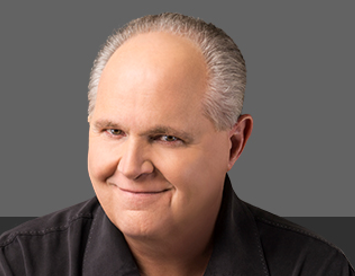
Take President Trump, for example. Last Friday, after being stricken with COVID-19, he spent two hours chewing the fat with Rush Limbaugh. The bombastic radio host called it a “Mega MAGA Rally.”
Perhaps so, but when it comes to media access, the President knows what works. Limbaugh’s “Excellence In Broadcasting Network” runs on 650 stations nationwide, the prefect way to reach his base – perhaps his key to his getting elected or rejected.
A recent think piece in the New York Times by Paul Matzko connected the dots. In “Talk Radio Is Turning Millions of Americans Into Conservatives,” Matzko makes the case that conservative talk’s 15 million strong weekly audience has been successfully influencing politics in this country for at least two decades.
Yet, few media and political pundits give radio its props. As Matzko notes, “Talk radio still somehow manages to fly below the national media radar.” That’s because so many educated professionals and pundits don’t listen to it, much less understand it.
He also credits radio’s unique, ubiquitous, and multi-platform properties:
“Talk radio is not bounded by physical space. It can follow listeners wherever they go, from the car radio while commuting to the radio resting on the workbench to a radio app on a smartphone. It has the potential to dominate the construction of a person’s worldview in a way that other media simply cannot.”
Not bad for a medium that “no one listens to,” that has no demonstrable R.O.I., or that has simply become passé. In fact, Matzko submits that whether Trump remains in office or leaves Washington, conservative talk radio “will also outlast him.” And you have to wonder at some point whether he might not become a part of it.
And then there’s the Biden campaign. In a story last week in The Hill, Marty Johnson reports how Biden’s strategy is to go after Black, Latino, and rural voters in “battleground states” like Texas, Wisconsin, Arizona, Michigan, and others.
What does that look like?
McClatchy’s Adam Wollner says Biden is doubling down on radio as we head into the stretch run of this campaign. In a special election coverage section calls “Impact 2020,” the story’s title says all you need to know:
“Biden is outspending Trump by more than 50-1 on radio ads”
What are the Democrats thinking? Wollner explains how the Biden campaign is using an “old-school platform” to laser target rural, older, Black, Latino, and Christian voters.
If your station’s Q4 perks up, it may be because you’re licensed to a market in one of those Electoral College “tipping states” where every vote truly counts. Wollner says Biden has poured $15 million into radio since early September. And as you’ll notice from the chart below, he’s focusing radio dollars on some states most Democrats usually couldn’t find on a map: Georgia and Texas among them.
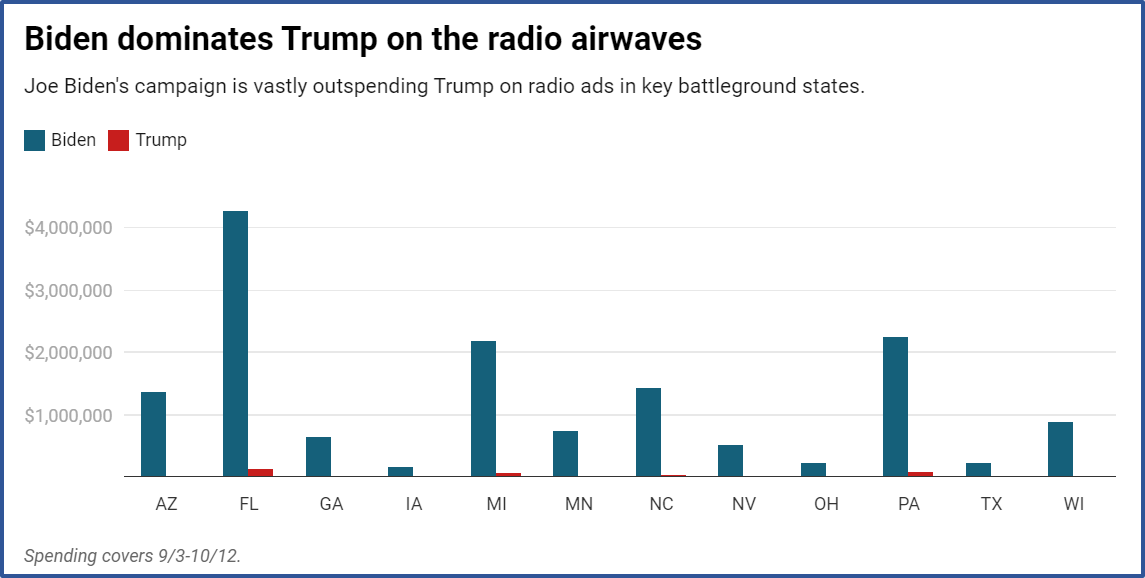
As we know, this election may go down in history as a referendum on a lot of things – and among them, the efficacy of radio advertising. Back in 2013, we were looking at an environment where radio ads were out of favor. Buys were placed when TV was sold out. Today, radio could be a difference-maker in determining the Electoral College outcome, and in the process, the election itself.
That the Biden campaign is surgically choosing the radio formats and stations in key markets, regions, and states speaks to the value and ease of radio targeting. We vividly saw this in our COVID 3 study Paul and I presented yesterday in collaboration with the RAB. Because the pandemic has become so politicized, we have been asking respondents for their party preference.
In this new study, we had enough sample (27,000+ respondents) to break it down by format, a useful tool for programmers and salespeople – not to mention politicians.
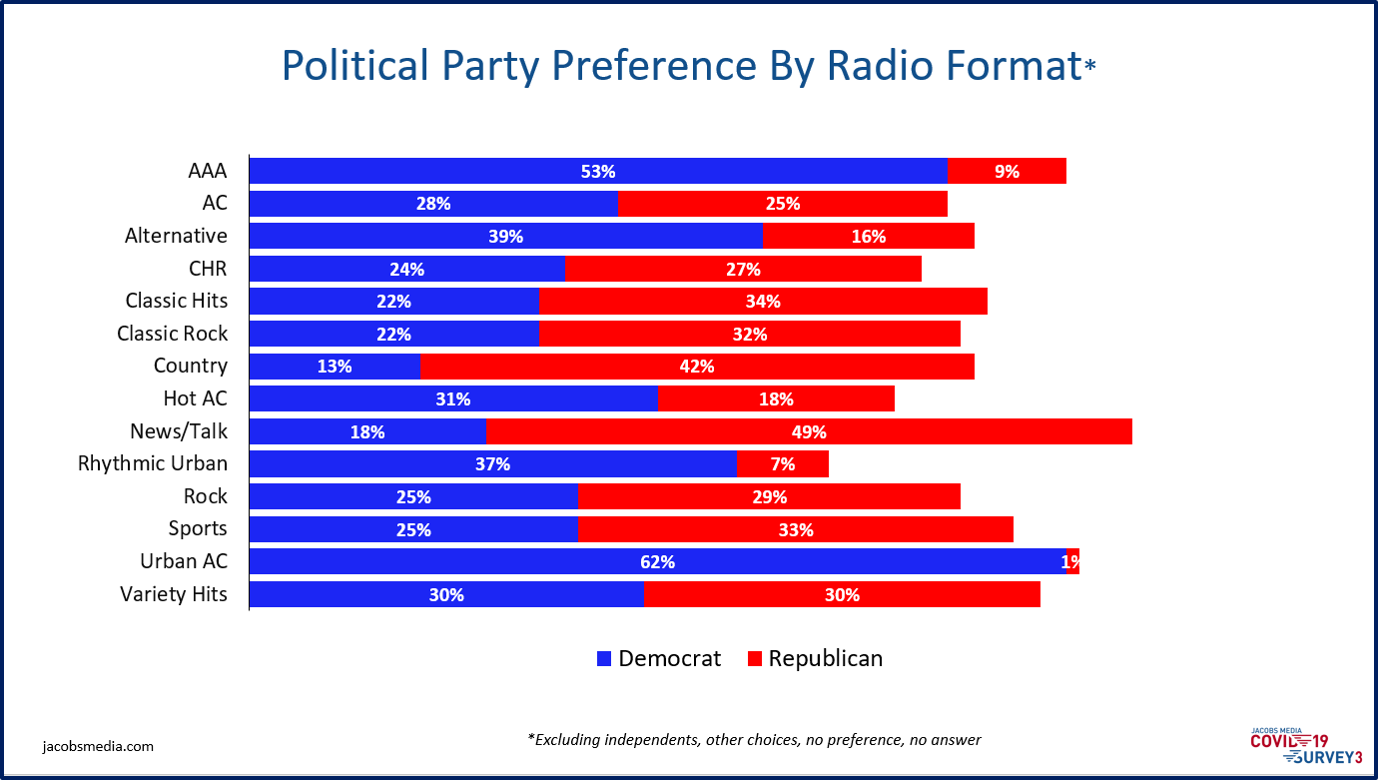
Cynics, doubters, skeptics, and haters will no doubt mention that each candidate is a septuagenarian – decades older than radio’s most desirable demographics. You’d have to wonder whether Mayor Pete would have been as bullish on radio.
And to be fair, many more dollars are being poured into other media categories by both campaigns. In the big scheme of things, the Biden campaign now has the financial edge. In a chart that appeared in a Bloomberg Government email, Advertising Analytics lays out each campaign’s ad spend this way. (Apologies on the graphic – I am waiting for the original and will make the necessary replacement.)
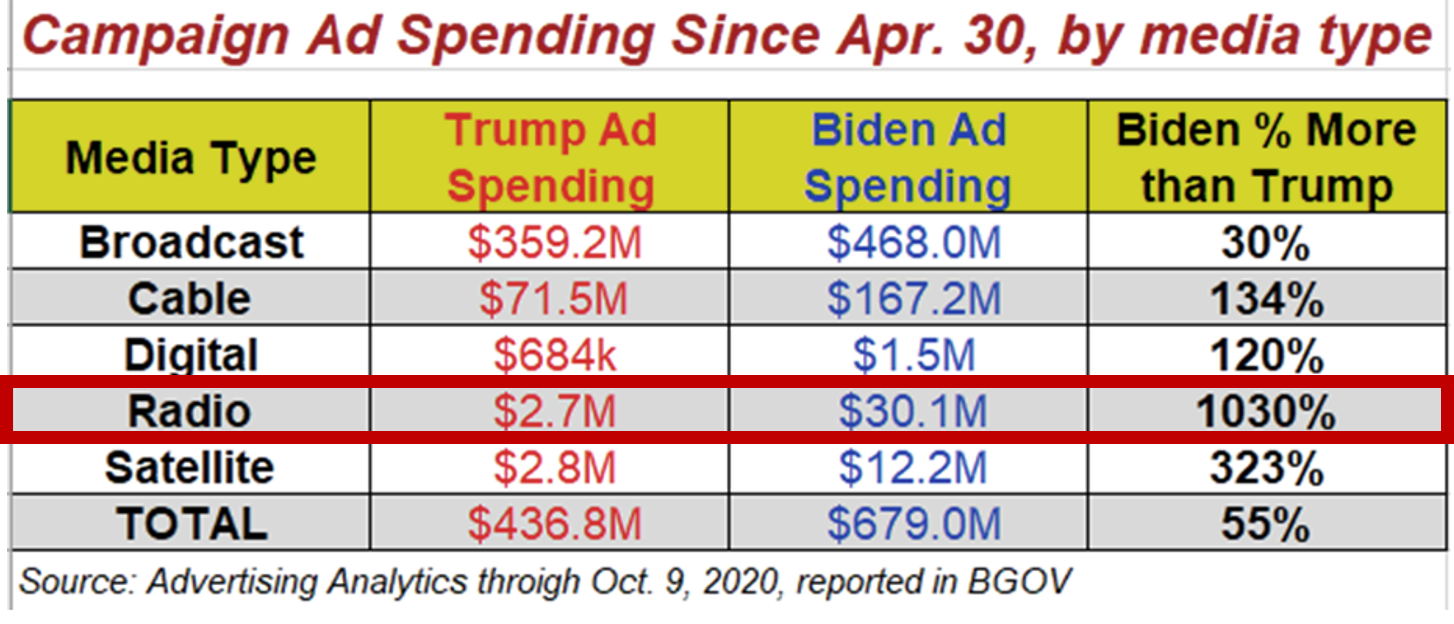
Yes, Biden has a huge advantage in overall campaign advertising at this point in the contest, and you can see his advantage on TV (labeled as “broadcast”), satellite radio, digital, and cable TV.
But it’s in radio where Biden’s brain trust is placing their chips. $30 million dollars isn’t a rounding error. Nor is it a “let’s throw a few dollars at radio and see what happens” tactic. It is part of Biden’s communication strategy in key markets and races.
And that means it’s a test case for radio.
It sure looks like November 3rd will be an important day.
Thanks to Steve Goldstein & Bill Jacobs.
- What To Do If Your Radio Station Goes Through A Midlife Crisis - April 25, 2025
- A 2020 Lesson?It Could All Be Gone In A Flash - April 24, 2025
- How AI Can Give Radio Personalities More…PERSONALITY - April 23, 2025




Hooray for radio!!! Finally, something great to come out of this election cycle! The breakdown of party identification by format is fascinating. What is really a surprise when I think about it is how the classic rock audience leans Republican. It’s a given now, but when that music was current, wasn’t the listeners of the stations that played it fairly liberal? I’m old enough to remember when what’s considered classic rock was current, but too young to notice that paradigm shift that happened right under my nose. Any idea when this occurred and any explanation (theory) why in your past research?
Kurt, the Classic Rock switcheroo has been happening for some time now. I think that a) the liberal tilt back in the Woodstock Era was overblown, and b) was more common to people who are now 60+, not many of the people listening to these radio stations in 2020. Thanks for the comments on the blog.
Thanks for pointing out, Fred, that both candidates are in their 70s. Regardless of who wins the election,I am hoping that the takeaway in the advertising community is that 55 is (and always has been) an arbitrary cutoff for ad buys.
I know we’ve always explained it away by saying the agencies just do what their clients want, but maybe — just maybe — the VPs in charge of marketing and advertising at all the companies that use radio will see this as a wake-up call and realize that seniors do have money and can be targeted with ad buys.
This would be especially good news for the formats you and I consult, Fred. And I think there’s plenty of revenue to be made by the advertisers … and the agencies and programming consultants downstream from there. Lost revenue, that can be regained.
KM, they vote, they spend, and they even engage. Marketers should be chasing teens, of course, but at the expense of 55+? I don’t think so. And in the midst of a pandemic, AARPers have more cash. Thanks for the good points.
It’s good that campaigns are spending more money on radio but I was struck by the older blog post you linked to.
The way to be successful using radio is to have a powerful message.
More people make mistakes with the message as opposed to the medium.
That is why I am not surprised that the Democratic consultant in the past blog has the most doubts about the medium because Democrats have never been able to create effective messaging for their platform of ideas which, when stripped of ideology, prove more popular with Americans than the GOP’s only idea- cut taxes for the rich.
Do you trust Amazon, Facebook, Volkswagen and Exxon Mobil to have your best interest at heart? If not, then you shouldn’t want “Small Government” which means gutting the Federal Government for the benefit of Big Business and the wealthy.
Even the other day, a Democratic Senator talked about challenging the “Right To Work” laws which is what the GOP speciously call robbing workers of their right to unionize. What he should have called it is “Right to Work for Minimum Wage” or “Right to Be Fired without cause” law.
They are now discussing “Court Packing” which most Americans are against. I am sure many would be all in for “Court Balancing“ to really reflect all the viewpoints in this country though.
Democrats haven’t learned yet that many Americans are against “Obamacare” but LOVE the Affordable Care Act.
And only Democrats can concoct what has to be the worst slogan ever – “Defund the Police” – in advocating for many policy ideas that even Police forces have been talking about for years.
When you learn how to use the language, you can have impact with any audience and in any medium, especially one that BRANDS that message like radio.
It is also interesting that the consultant couldn’t point to digital as being effective yet he asks radio to show the wounds on the hands when he is talking about results.
I believe you’re correct, Mike, about messaging and branding – certainly Mr. Trump’s strongest suit. 2016’s “Make America Great” was certainly clear & more memorable than “I’m With Her.” And I’m not convinced that “Build Back Better” gets it done either. It is about more than what you buy – it is most definitely what you say.
Does this mean that left of center is more likely to mean left radio? Looks like radio is a medium for conservatives. Weight each format by % of listenership and its decidedly right of center.